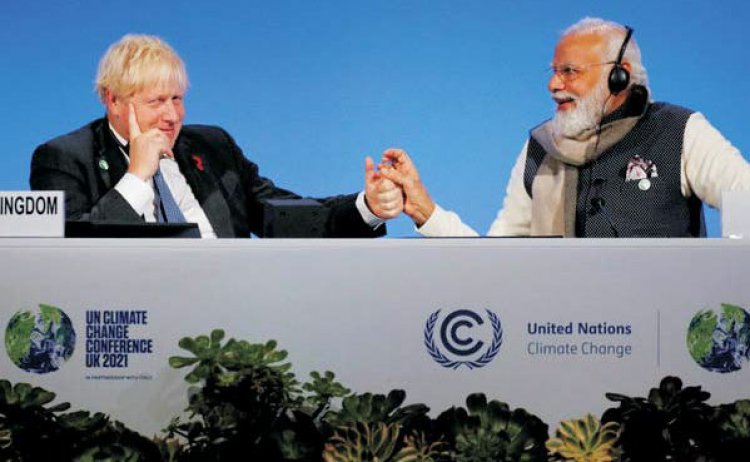Conference Of the Parties (Cop26) Summit: PM Modi’s Big Announcements
Asia News Agency

Climate has been the flavour of the global community this year. The G20 meeting and COP26, the annual climate summit under the UN Framework Convention on Climate Change (UNFCCC), were co-hosted Italy and the United Kingdom in Rome and Glasgow respectively. The Conference of the Parties (COP), opened on 31 October and will continue till November 12.
With the global focus on climate change, the Glasgow COP26 clearly overshadowed the G-20 summit, although 80 per cent of the world’s CO2 emissions emanate from its members. But the absence of Chinese President Xi Jinping and Russian President Vladimir Putin was a setback.
At the G-20 summit, Russia, India, Brazil, Saudi Arabia, etc resisted any new emission curbing goals. Despite that, British PM Boris Johnson, French President Emmanuel Macron and US President Joe Boden tried to extract caps on the use of coal and methane emissions, but only a compromise emerged. The communique reflects the softened stand on “Net Zero” emissions by 2050 as well as the “phasing out of investments in new unabated coal power generation capacity” as soon as possible, but not by 2030.
‘India would make a one billion-tonne reduction in projected emissions from now until 2030’
India set the tone and tempo at the CoP26 summit with Prime Minister Narendra Modi announcing a one billion-tonne reduction target in projected emissions from now until 2030.
He made five big announcements, accepting global demands to agree to a net-zero emissions target, setting a 2070 date to achieve it. He significantly increased India’s previous climate targets, mentioned in the promises made during the Paris Agreement. India’s target for installed renewable energy capacity by 2030 has been enhanced from 450 GW to 500 GW. At the same time, the share of non-fossil fuel energy in India’s total energy mix is now aimed to reach 50 per cent by 2030 instead of 40 per cent earlier.
In addition, India’s emissions intensity, or emissions per unit GDP, will be reduced by at least 45 per cent by the year 2030 from the 2005 levels. In its existing target, India had promised to reduce its emissions intensity by 33 to 35 per cent by that date.
Context of the one billion tonne reduction: This is one of the most important and unexpected. announcement. India is currently the third largest emitter of greenhouse gases, releasing over 3 billion tonne every year. According to World Resources Institute database, India’s total greenhouse gas emissions in 2018 was about 3.3 billion tonne, up from 2.5 billion tonne in 2010. At this rate, India’s projected emissions between now and 2030 could be in the range of 30-32 billion tonne.
But India’s emissions are rising, writes Amitabh Sinha (Resident Editor, Indian Express, Pune) “at about 4 to 5 per cent every year. So the total emissions between now and 2030 is expected to be much higher, in the range of about 40 billion tonne. It is in this amount, that a one billion tonne reduction has been announced.
“This is the first time India has taken any climate target in terms of absolute emissions. Before this, the closest reference to altering its emissions trajectory used to be in the form of emissions intensity. This is because under the international climate change architecture, only developed countries are mandated, and expected, to make reductions in their absolute emissions.”
















